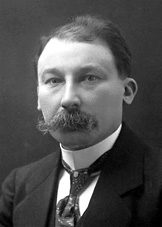- Victor Grignard
Infobox_Scientist
name = François Auguste Victor Grignard
image_size=180px
birth_date =May 6 ,1871
birth_place =Cherbourg ,France
nationality =France
death_date = death date and age| 1935|12|13|1871|5|6
death_place =Lyon ,France
field =Physical chemistry
work_institution =University of Nancy
alma_mater =University of Lyon
known_for =Organic chemistry
prizes =Nobel Prize for Chemistry (1912)François Auguste Victor Grignard (
May 6 ,1871 inCherbourg -December 13 ,1935 inLyon ) was aNobel Prize -winning Frenchchemist .Grignard was the son of a sail maker. After studying mathematics at Lyon he transferred to chemistry, becoming a professor at the
University of Nancy in 1910. During World War I, he was transferred to the new field of chemical warfare, and worked on the manufacture ofphosgene and the detection ofmustard gas . His counterpart on the German side was another Nobel Prize winning Chemist,Fritz Haber .He is most noted for devising a new method for generating carbon-carbon bonds using magnesium to couple ketones and alkyl halides. [cite journal
title = Sur quelques nouvelles combinaisons organométalliques du magnèsium et leur application à des d'alcools et d'hydrocarbures
author = V. Grignard
journal = Compt. Rend.
volume = 130
issue =
pages = 1322
year = 1900
url = http://gallica.bnf.fr/ark:/12148/bpt6k3086n/f1322.table
doi = ] This reaction is valuable in inorganic synthesis . His occurs in two steps:#Formation of the "
Grignard reagent ," which is an organomagnesium compound made by the reaction an organohalide, R-X (R =alkyl oraryl ; and X is ahalide , usuallybromide oriodide ) withmagnesium metal. The Grignard reagent is usually described with the general chemical formula R-Mg-X, although its structure is more complex.
#Addition of thecarbonyl , in which aketone or analdehyde is added to the solution containing the Grignard reagent. The carbon atom that is bonded to Mg transfers to the carbonyl carbon atom, and the oxygen of the carbonyl carbon becomes attached to the magnesium to give analkoxide . The process is an example of anucleophilic addition to a carbonyl. After the addition, the reaction mixture is treated with aqueous acid to give an alcohol, and the magnesium salts that are discared.The Grignard reaction is an important means of preparing organic compounds from smaller precursor molecules. For this work, Grignard was awarded the
Nobel Prize in Chemistry in 1912 jointly with fellow Frenchman Paul Sabatier.References
*
*
*
*External links
* [http://nobelprize.org/nobel_prizes/chemistry/laureates/1912/grignard-lecture.html Nobel Lecture] "The Use of Organomagnesium Compunds in Preparative Organic Chemistry" from Nobelprize.org website
* [http://nobelprize.org/nobel_prizes/chemistry/laureates/1912/grignard-bio.html Biography] Biography from Nobelprize.org website
* [http://www.academie-sciences.fr/publications/comptes_rendus.htm Comptes Rendus]
Wikimedia Foundation. 2010.
